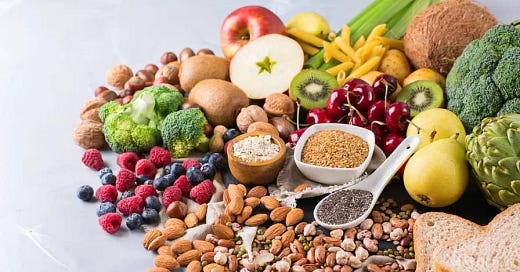Dear Dad,
Eat more fiber. Have you ever heard this health instruction? If you have, which hopefully you have, you’ve also probably wondered what is fiber and why am I supposed to eat it?
Dietary fiber is the indigestible portion of plant foods. As you know, your body regularly digests and absorbs carbs, fat, protein, and other minerals from the food that you eat. But what you might not know, or care to think about, is that you regularly eat things that are not digested and instead pass right through your digestive system without being absorbed. A bulk of these substances are “fiber.”
Fiber comes from the molecules that form the structure of plants. Think of fiber as the skin and bones of plants that you eat. For example, when you eat a potato the outer skin is loaded with fiber and the flesh of the potato has various fibrous networks throughout, which hold the whole plant together (But most the fiber is contained in the skin so don’t peel it off!). There are two types of dietary fiber; soluble fiber which dissolves in water and insoluble fiber which does not.1
Only 7% of American’s meet the daily recommended intake of dietary fiber.2 “Health guidelines recommend eating 14 grams of fiber for every 1,000 calories consumed daily.”3
The time to write more about fiber is now! Once you understand the problems with the Standard American Diet (SAD) it’s not a puzzle that most of us eat woefully inadequate amounts of fiber. Food processing eliminates most of our foods fiber in exchange for shelf life and mouth feel then leaves us dangerously lacking fiber in our diets.
But, if fiber is indigestible and only passes through the digestive system unabsorbed what makes it so important? There are many reasons, but let’s talk about three: moderating blood sugar, weight management, and feeding your gut bacteria.
First, fiber helps moderate blood glucose levels by slowing the absorption of sugar into the blood stream. For example, when you drink apple juice your blood sugar spikes almost immediately. However, when you eat an apple, the fiber (skin & bones) in the apple slow down the body’s ability to absorb the sugar quickly. This causes a slower influx of sugar into your blood which in turn allows your body to release less insulin and at a slower rate. Thus, eating a high fiber diet can play a significant role in managing type-two-diabetes as well as overall health.
Second, fiber helps with weight management. Not every calorie eaten is digested and absorbed into your body. This important when considering the amount of calories to eat to lose or remain at a healthy weight. The indigestible fiber, which passes through the digestive track unabsorbed will pull other swallowed food (calories) through with it. Therefore, if you eat a diet high in fiber you will actually be absorbing less calories than what appears on the nutrition label. This tactic does not lead to any quick impacts on weight but it will make a difference over the long-haul (two calories less per day would equate to about 5.5 lbs in 10 years). And that’s what counts!
Finally, fiber feeds your gut bacteria. While your body doesn’t digest fiber the bacteria in your gut does! (which is a good thing and the frontier of some of the most recent and fascinating nutrition research). We have a symbiotic relationship with the bacteria in our guts, which are also called probiotics. You may have heard of the terms probiotics, prebiotics, and postbiotics before but here’s what they mean: probiotics are gut bacteria which eat prebiotics and produce postbiotics. Fiber, a source of prebiotics, passes through your digestive tract and gets consumed and metabolized by the probiotics in your gut, which produces postbiotics. The postbiotics released when gut bacteria metabolizes fiber aids the immune system, enhances metabolism, and strengthens the nervous system, to name a few of various health benefits. Feed fiber to your gut bacteria for numerous health benefits!
Many people get so distracted by whether carbs are good or bad, or how much protein to eat, that fiber is left unaccounted for and not thought about. Don’t fall into this trap, eat the skin and bones of your plants! Specifically, eat large amounts of whole grains, fruits, vegetables, beans, legumes, nuts, and seeds! Should sound familiar by now…
With Love,
JSR




